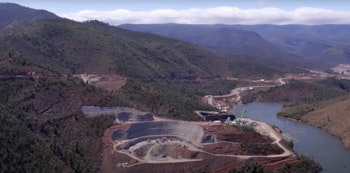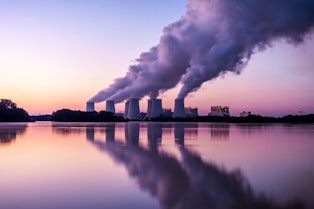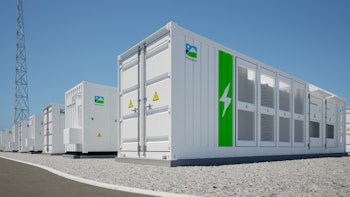Australia is all pumped up about pumped hydro. A company called Acen is looking to build an 800 MW project in New South Wales. Energy Australia wants to create one near Lithgow.
And Australia’s biggest hydro power scheme, Snowy Hydro 2.0, continues to make headlines—albeit not for the right reasons, with reports of delays, cost overruns and executive changes. Nevertheless, there is no doubt this interest in pumped hydro is justified.

As Australia transitions to a low-carbon energy system, the grid needs more dispatchable power for times when wind and solar plants are not producing electricity. Pumped hydro is well suited to the task.
It works by linking two reservoirs, at different heights, with a network of pipes. When renewable energy is plentiful and cheap, it can be used to pump water from the lower reservoir to the higher one.
When renewable energy is no longer available, for example on a calm night, the water can be released from the higher reservoir to the lower one, powering a hydro turbine and producing electricity in the process.
The beauty of pumped hydro is that it can store massive amounts of energy. Snowy Hydro 2.0, for example, is expected to boast 2 GW and 350 GWh of capacity when it enters operation, possibly by 2028. That’s a lot of storage—but it isn’t enough.
Pumped hydro projects like Snowy Hydro 2.0 are great once they are up and running, providing large amounts of low-cost energy storage that can be exploited for decades. But they are also large, complex projects that can experience delays and cost overruns.
Furthermore, because of their size they can attract opposition from environmental and community groups. Witness the outcry, for example, over Energy Australia’s Lithgow project, where local residents fear for the fate of platypus living in a lake that will be used as the lower reservoir.
All this means some of the pumped hydro capacity planned for Australia may never be built, and other projects may come online significantly behind schedule. Yet the country needs energy storage now, as Australia hastens to close its coal-fired power plants.

The 2.2 GW Loy Yang A Power Station’s closure has been brought forward a decade, from 2045 to 2035. The 2.9 GW Eraring plant, previously due to close in 2032, will now shut in 2025. Yallourn Power Station, with 1.5 GW of capacity, will close in 2025, four years ahead of its original schedule.
By 2040, it is unlikely there will be any coal-fired plants running in the country. Given the extent to which coal generation contributes to global warming, this is great news for the environment.
But some experts worry that clean energy isn’t coming online fast enough to replace the lost coal generation. Australia should be installing double the amount of renewables it is at the moment, according to the University of New South Wales. The same argument goes for energy storage.
If we need all the renewable energy we can get, then it makes sense to store whatever we can while it is available. Pumped hydro can help with that, but only once the plants are built. In the meantime, we need another form of storage, and fast.
Luckily, the answer is at hand—and Australia already leads the way in it, as it does in many other areas of the energy transition thanks to the efforts of bodies such as the Australian Renewable Energy Agency (ARENA) and the Clean Energy Council.
In energy storage, it is hard to find anything that is quicker and easier to install than a lithium-iron-phosphate battery plant.

In December 2022, Federal Minister for Climate Change & Energy, Chris Bowen, announced that eight new grid-forming batteries would share in AUD$176 million funding through ARENA’s Large Scale Battery Storage funding round.
Each of the eight grid-scale lithium-ion batteries will be at least 200 megawatts MW and 400 MWh in size, with advanced grid-forming inverters. Together, the new batteries will have a combined capacity of 2 GW and 4.2 GWh, totalling a reported $2.7 billion project expenditure.
That’s enough to power the entire state of Tasmania for more than three hours using stored renewable electricity. And these projects will be operational in a relatively short period of time compared to pumped hydro.
Even the world’s one-time largest battery storage system, Australia’s Hornsdale Power Reserve, was completed in just 63 days from contract signature to grid connection.
The components are easy to source, particularly for Pacific Green since it has strong supply chains and pre-integrated solutions within containers for easy transport and installation.
Unlike pumped hydro stations, which require the right geographical locations for two close-by reservoirs at different heights, battery plants can be installed almost anywhere there is a grid connection.
They are ideal for brownfield sites, even close to built-up industrial areas, because they are within tolerance for industrial noise levels and do not affect the skyline or the local wildlife. But perhaps the best location is close to other energy assets.
When co-located with solar parks or wind farms, for example, battery systems can help make better use of the grid connection. If renewable energy production exceeds what the grid can accept, the battery can store the excess until the solar or wind output drops.
In the UK, Pacific Green is developing this idea with an energy park concept at a site called Richborough, on the coast of Southeast England. The site is a landing point for electricity from offshore wind as well as an interconnector that goes to mainland Europe.
It also happens to be the site of a decommissioned coal power plant, which is ideal because there is an existing connection to the UK electricity network. There is no reason why a similar model could not be used in Australia.
Indeed, repurposing Australia’s retiring coal stations as energy storage hubs would have a double benefit.
On one hand, it would allow the Australian energy system to lose coal-fired generation with only minimal impact on the grid, because the lost capacity could soon be made up for with battery storage.
On the other, it could help provide ongoing employment to some of the people who depend on the coal power industry.
Battery systems generally do not require much in the way of upkeep but there are job opportunities in the construction phase and potentially thereafter, particularly if batteries are combined with other clean energy infrastructure.
In Australia we have already got the technology, the know-how and the soon-to-be-decommissioned coal plants… so what are we waiting for?
Publish date: 09 March, 2023